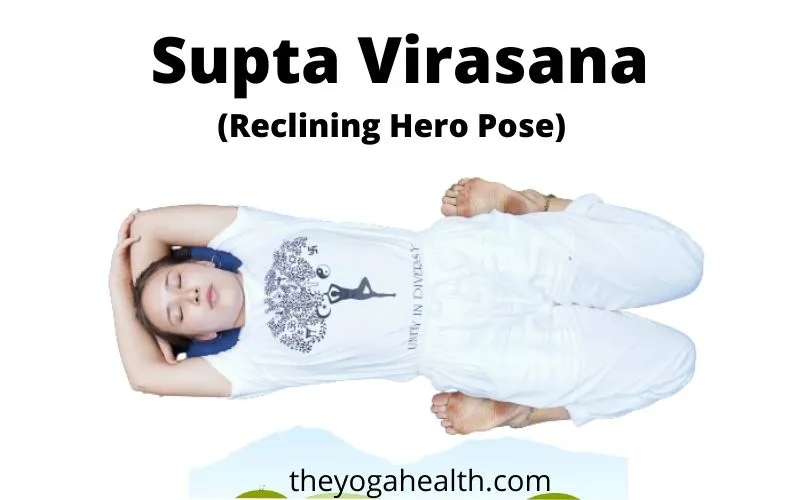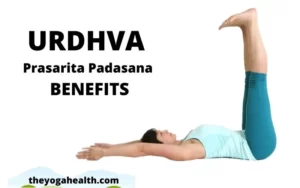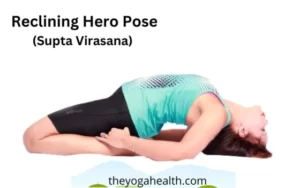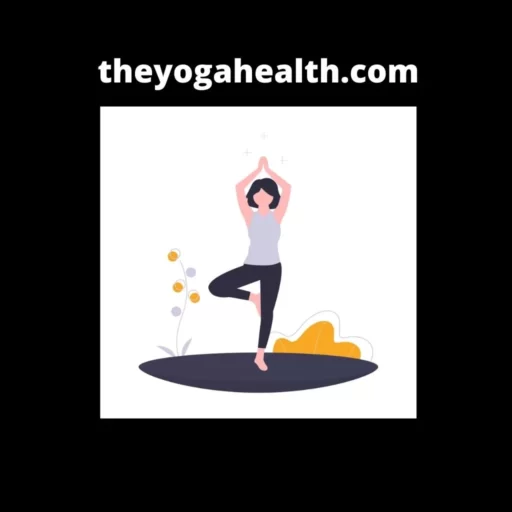Yoga is an ancient health science that covers a wide range of poses, each pose has its own unique benefits. One such pose is the Hero Pose, also known as ‘Virasana’ in the Sanskrit language.
Table of Contents
Virasana (Hero Pose)
‘Vira’ in the Sanskrit language means a ‘hero’ or ‘champion’. This pose is done by sitting on the floor, keeping the knees together, spreading apart the feet, and resting the feet by the side of the hips.
This seated pose may appear simple, but it has lots of benefits to the mind and body. In this article, we will explore Hero Pose, to understand its essence and potential benefits.This pose is excellent for doing Pranayama and meditation.
Virasana (Hero Pose) Basic Details:
| Sanskrit Name | Virasana |
| English Name | Hero Pose |
| Difficulty Level | Intermediate |
| Position | Sitting |
| Type | Stretch |
Hero Pose steps
1. Kneel down on the Yoga mat, bending your knees keeping them together now spread your feet apart so much that your buttocks should come in between your feet and not on your feet.
2. Now rest your buttocks on the floor, your feet are kept by the side of your thighs, the inner side of your calf should be touching the outer side of its respective thigh.
3. Keep your toes pointing back and touching the floor keep your wrists on your knees, palms open, now join your tips of the thumbs and forefingers. Keep your other fingers extended. Stretch your back erect, (as shown in the picture).
4. You can stay in this position as long as you want while breathing deeply.
5. After that rest your palms on your knees for a while.
6. Now interlock your fingers and stretch your arms straight over your head.
7. You can stay in this position for about a minute with deep breathing.
8. Now breathe out and release your finger’s locks. Now Place your palms on your soles, bend forward and rest your chin on your knees.
9. You can stay in this position for about a minute with normal breathing.
10. Now breathe in and raise your trunk up, bring your feet forward and relax.
In the beginning, if you find this pose difficult to perform because you may find it difficult to place your buttocks on the floor and your feet on the side of your thighs.
In that case, you can try placing your feet one on another and resting your buttocks on them. (As in the picture) Gradually you can practice spreading your feet apart and bring them to rest outside your thighs.
Precautions
Just like any other yoga pose it is important to practice the Hero Pose with caution and awareness to avoid any injuries.
As this pose involves kneeling on the floor where the pressure of the full body weight comes on the knees so every attempting this yoga pose at home without expert guidance must take extra precautions.
- Start with a few gentle warm-up exercises to loosen the leg muscles, ankles, and knees. Warming up prepares the body for this pose thereby reducing the risk of discomfort, strain, or injury.
- If you experience any tightness in your knees or ankles or you find it difficult to sit on the floor then consider using yoga blocks, cushions, or folded blanket. Slight elevation of the hips can reduce strain on the knees and ankles, making this pose easier for beginners.
- If you are new to this pose and your leg muscles are not that flexible then avoid forcing yourself to do the complete pose. Instead, start by gently learning the pose, gradually increasing the duration as your flexibility improves over time. Rushing into the complete pose can lead to injury, strain or discomfort.
- If you feel any pain or discomfort or stress in your legs, knees, ankles, or lower back then immediately come out of the pose and take a rest. Do not push yourself beyond your physical capacity.
- If you have any injury on the legs, knees, or ankles then it’s better to avoid this pose or you can with the help of your yoga instructor do some modification to do this pose.
Hero Pose benefits
1.Alleviating Rheumatic Knee Pain: Hero Pose can work wonders in relieving rheumatic pain in the knees. This seated yoga posture involves gently bending the knees, which helps in improving blood circulation around the knee joints.
The increased blood flow helps in reducing inflammation and stiffness, providing much-needed relief to individuals suffering from rheumatic knee pain.
2. Gout Relief with Hero Pose: For those grappling with the discomfort of gout, Hero Pose can offer significant relief. Gout disease is a type of arthritis which is caused by the accumulation of uric acid crystals in the joints that often leads to severe pain and inflammation.
The gentle stretching and opening of the knee and ankle joints in Virasana can help to flush out toxins and reduce uric acid build up, thus alleviating the symptoms of gout.
3. Correcting Flat Feet: Flat feet occur when the arches of the feet collapse, leading to imbalances in the foot structure and potential discomfort. Hero Pose comes to the rescue by properly stretching the ankles and feet, which can gradually help in the formation of better arches.
Consistent and daily practice of this asana allows for a gradual correction of flat feet, providing improved support and stability to the feet.
4. Forming Proper Arches: As mentioned earlier, Hero Pose plays a crucial role in forming proper arches in the feet. But it is important to remember that this process takes time and regular practice.
By spending a few minutes each day in this pose, individuals can stretch and strengthen the ankle and foot muscles, gradually encouraging the development of healthier arches for improved foot mechanics.
5. Heel Pain Relief: If you’re experiencing any pain in your heels, Hero Pose can be a soothing solution. The gentle stretching and opening of the feet in this pose can help relieve tension in the plantar fascia, it is a band of tissue that supports the arches and connects to the heels.
By regularly practicing Virasana, individuals with heel pain can find relief and ease in their daily movements.
6. Easing Calcaneal Spurs: Calcaneal spurs, also known as heel spurs, are bony outgrowths that can develop on the heel bone, causing discomfort and pain. The regular practice of Hero Pose can help in providing relief to those suffering from calcaneal spurs.
As the ankles and feet are gently stretched and strengthened in this pose, the spurs can gradually diminish, promoting improved foot health and reducing discomfort over time.
This pose can be done immediately after having meals and it will relieve heaviness in the stomach.

Reclining Hero Pose (Supta Virasana)
‘Supta’ in the Sanskrit language means ‘lying down’ This asana is performed by reclining back on the floor and stretching the arms behind the head.
Reclining Hero Pose Steps
1. Sit in Virasana as prescribed above.
2. Breath out and recline your trunk back and rest your elbows one by one on the floor.
3. Now release the pressure on your elbows one after the other by extending your arms.
4. Now first rest the crown of your head on the floor and slowly rest the back of your head on the floor, after that slowly rest your back on the floor.
5. Now take your arms over your head and stretch them out straight. You can stay in this position as long as you can with deep breathing.
6. After that place your arms beside your trunk, press your elbows on the floor, and sit up again while breathing out.
The hands can be stretched over your head or placed beside your thighs. When your hands are stretched over your head do not raise your shoulder blades from the floor.
If it is difficult to perform, beginners can keep the knees apart.
Reclining Hero Pose Benefits
1. In this asana the abdominal organs are stretched fully.
2. The pelvic region is also stretched during this asana.
3. People whose legs ache will get relief if they hold this asana for about 10 minutes.
4. This asana is excellent for athletes.
5. For those people who have to walk or stand for very long hours, this asana is especially recommended.
6. This asana can be performed even after meals.
7. If this asana is done before sleep at the night the legs feel rested the next morning.
8. People who do long marches feel greatly relieved by this asana combining it with Sarvangasana (Shoulder Stand)
Conclusion:
Hero Pose (Virasana) offers various benefits for knee pain, gout relief, flat feet correction, proper arch formation, heel pain, and calcaneal spurs, it’s essential to practice this asana with proper alignment and under the guidance of a qualified yoga instructor, especially if you have any existing medical conditions or concerns.
Consistency with patience in your yoga practice will lead to the best results. Good Luck!
FAQ: Hero Pose
Q1. What muscles are benefitted from the hero pose?
Ans: This pose benefits the muscles of the Hips, knees, and quadriceps.
Q2. Is the hero pose good for digestion?
Ans: This pose helps to relieve gas-related issues in the stomach and thus aids in digestion.
Q3. Is the hero pose bad for knees?
Ans: If you are already suffering from any Knee injury or you are having weak muscles around your knees then this pose should be avoided till that injury is fully recovered and you have gained sufficient strength in your muscles to start practicing this pose.
When this asana is regularly performed by Yoga practitioners it gives strength and lubrication to the knees and keeps them strong till old age.
Q4. What is the difference between Vajrasana (Thunderbolt Pose) and Virasana (Hero Pose)?
Ans: These two asanas come under the seated simple poses and both look quite similar because in both of these poses knees are bent and feet are placed behind.
The difference between the two is that in Virasana the buttocks are placed on the floor with the feet placed hip-distance apart.
On the other hand in the Vajarasana buttocks are placed on the heels of the feet placed behind.
In this way, Virasana (Hero Pose) is hard to perform and Vajrasana (Thunderbolt Pose) is quite easier to perform in comparison with Virasana.
If you have any questions regarding Hero Pose (Virasana) you can ask in the comment section below.





